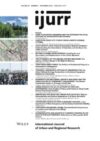In this article, we chart the evolving aesthetic contours of urban metabolism across London, focusing on the River Lea and Thamesmead to the north and south of the River Thames, respectively. We begin in the nineteenth century, when these two sites formed critical nodes within a new sewerage system that relegated the city’s circulatory flows to a subterranean network of pipes, cables, conduits and tubes. In the contemporary city, this metabolic network is being radically reconfigured. Contemporary landscape design interventions are beginning to unmake the concretized and canalized systems that provisioned the modern metropolis. On one level, this shift is being driven by an attempt to remediate and reconcile the city’s historically polluted, toxic urban landscapes. On another, it is looking to expose the previously hidden abodes of the metropolis by repositioning metabolic processes above rather than below ground within a new operational urban form. We interrogate this pursuit for a new urban metabolic aesthetic by exploring not only what it is rendering visible but also what it is rendering obscure. We conclude by contending that the ongoing rescaling of urban metabolism is being aestheticized in ways that are beginning to give rise to a new politics of in/visibility.
Details
Written by:
Ben Platt, Zuhri James
Digital Object Identifier (DOI)
https://doi.org/10.1111/1468-2427.70030
About DOI
